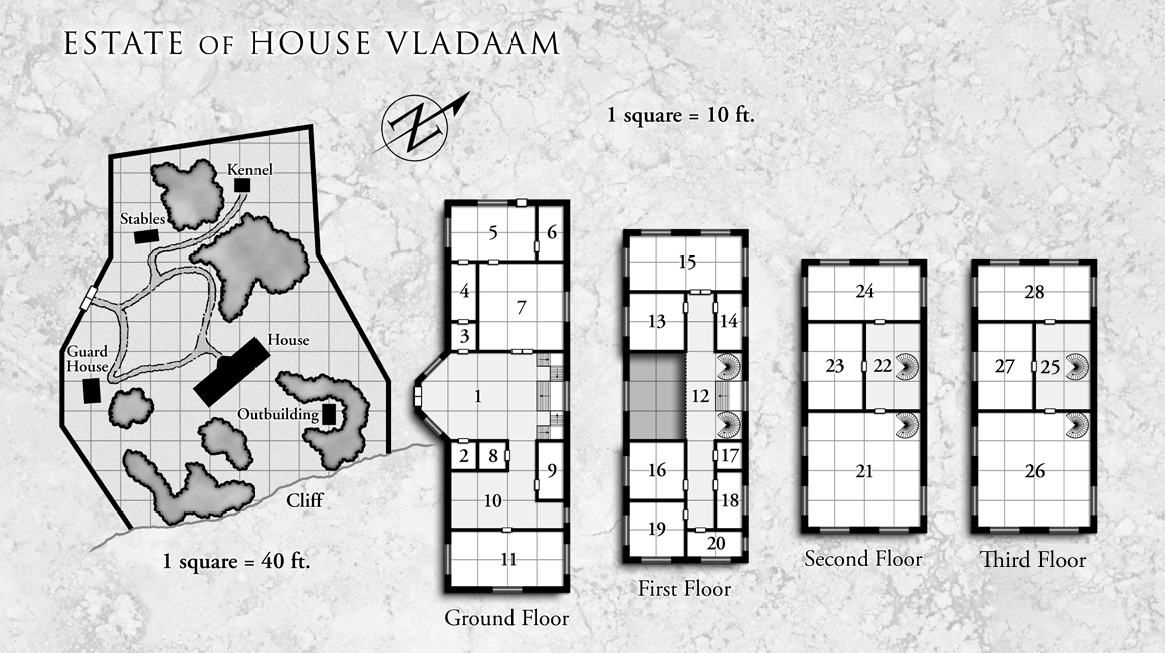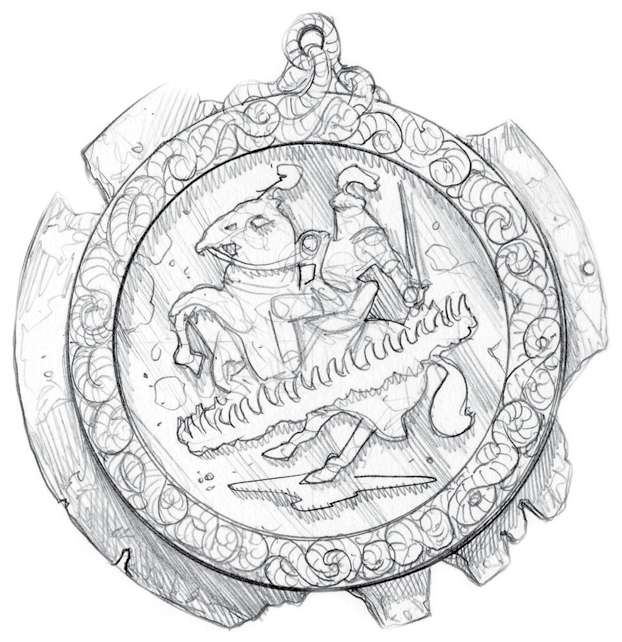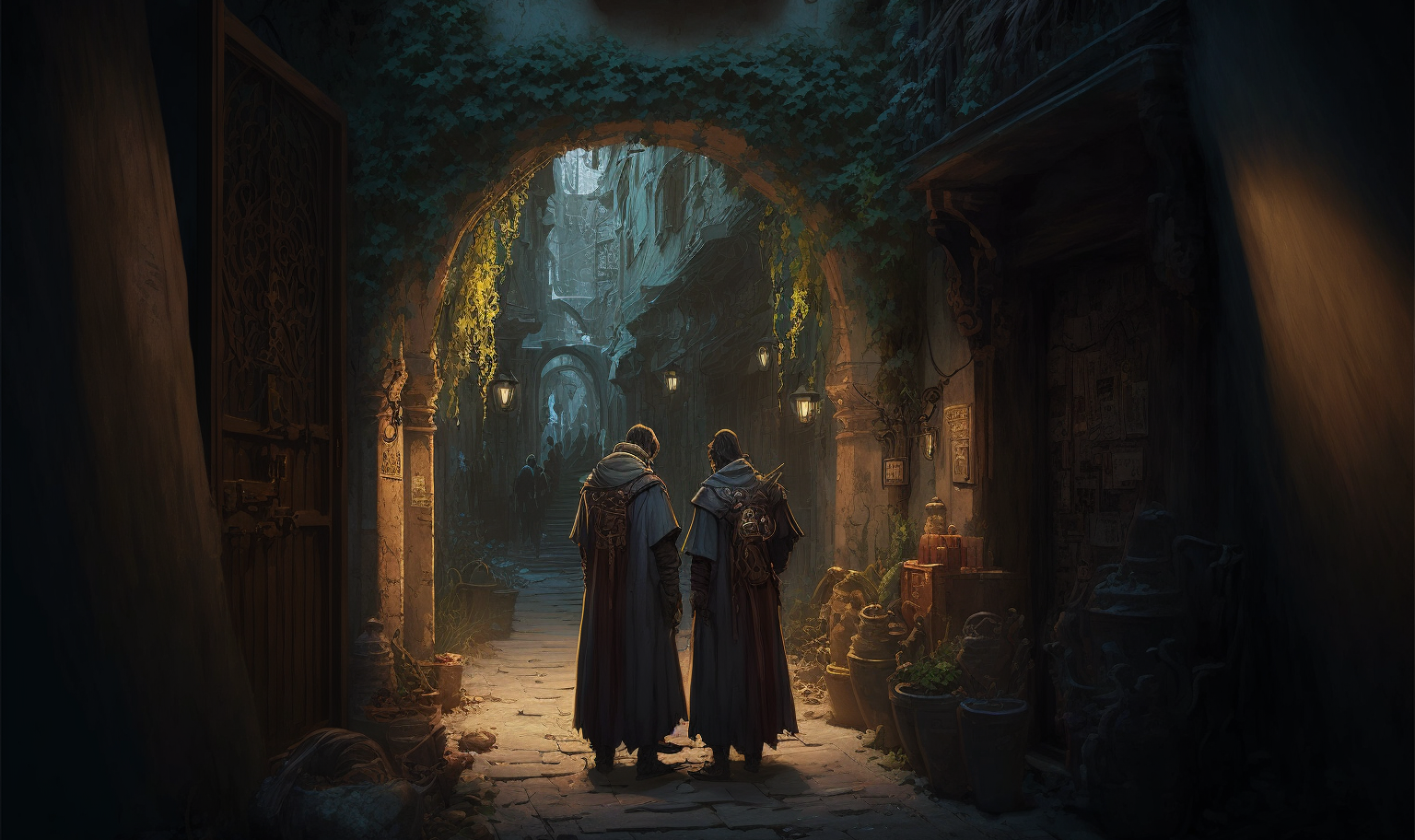Although briefly described in the Ptolus sourcebook, the Vladaam Estate was originally published and fully detailed in the Banewarrens campaign book five years earlier in 2002. This, unfortunately, resulted in some continuity errors.
The key problem is that the Vladaam family was not fully detailed in the Banewarrens. Only Iristul, Navanna, and Aliaster are mentioned, and as a result the Vladaam Estate lacks rooms for the other siblings. While it’s possible that Godfred and Gattara simply keep their rooms elsewhere, I decided it would make more sense to add the rooms to the mansion, which I did by simply adding a third floor identical to the second (as shown on the map above).
I’ve added key entries for these new rooms, as well as adding some enhancements to other rooms in the mansion. You’ll also find an adversary roster below, which is quite useful if you end up needing to run a true heist at the Vladaam Estate.
ADVERSARY ROSTER
There are two adversary rosters for the Vladaam Estate: One for daytime and another at a night (when security is higher, but the servants are asleep).
If the estate is on high alert, use the nighttime roster during the day. If Navanna is leading the PCs on a fake heist (see Banewarrens, Chapter 4), use the daytime roster at night (but still have the servants asleep).
Vladaam Guards: Banewarrens, p. 45.
VLADAAM ESTATE – DAYTIME
| Action Group | Location |
|---|---|
| 5 Guards | Guard House |
| Stegoar (Claw) + 8 Guard Wolves | Kennel |
| 1 Dire Wolf (Wolf Mum) | Kennel |
| 1d8 Claws | Outbuilding |
| 2 Guards | House 2 + House 3 |
VLADAAM ESTATE – NIGHTTIME
| Action Group | Location |
|---|---|
| 5 Guards | Guard House |
| 8 Guard Wolves | Grounds |
| Stegoar (Claw) | Kennel |
| 1 Dire Wolf (Wolf Mum) | Kennel |
| 1d6+4 Claws | Outbuilding |
| 2 Guards | House 2 + House 3 |
| 1 Guard | House 7 |
| 1 Guard | House 11 |
| 2 Guards | House 12 |
SERVANTS
| Action Group | Location |
|---|---|
| 6 Groomsmen | Stables |
| 4 Servants | Kitchen [sleep at night] |
| 4 Servants | Pantry [sleep at night] |
OTHER FAMILY MEMBERS
- Godfred: If present during Navanna’s fake heist, he’ll be drunk and potentially foul it up. 50% chance he’s in his room (1 in 10 chance he comes out looking for more liquor). 50% chance he’s out drinking (1 in 10 chance he comes home early).
- Aliaster: 40% chance of being out during the day. 90% he’s at home at night (sleeping).
- Gattara: 10% chance she’s present.
REVISED KEY
AREA 11 – LIBRARY
Very well stocked, the Vladaam library seems particularly complete on the subjects of history and magic. Many books here are valuable.
Secret Trap Door: Can be found with DC 20 Intelligence (Investigation) check. Leads down to the dungeons.
Chaos Lorebooks: Protected by a knavescour spell.
- Book of Faceless Hate
- Masks of Death
- Eye of Legion
- Hand of Gellasatrac
- Vested of the Galchutt
KNAVESCOUR
4th-level Abjuration [Warlock, Wizard]Casting Time: 10 minutes
Range: Touch
Components: V, S
Duration: 10 daysA particularly useful foil for thieves, knavescour allows you to designate 8 objects which you touch at the time of casting, anmd again once per day to maintain the spell.
If anyone intentionally touches any of these objects without your spoken permission, this spell causes it to spray corrosive energy at that creature, dealing 8d6 acid damage (Dexterity saving throw for half).
After this discharge, the object becomes safe for anyone to handle, and the other objects retain diminished protection. The second object touched without your permission deals one less die of damage than the first, the third deals two less dice, and so on.
At Higher Levels: You can designate an additional 4 objects for each spell slot level above 4th.
This spell is covered by the Open Game License.
AREA 22 – VLADAAM CREST
The original stone crest of the Vladaam family — roughly six feet in diameter — hangs above the door to Area 24.
AREA 24 – IRISTUL’S BEDCHAMBER
Locked Door: DC 23 Dexterity (Thieves’ Tools)
This room is tastefully decorated with grand furnishings, albeit in a slightly dated style. Although kept meticulously clean, any careful inspection of the room reveals that it has not been lived in for months or possibly even years.
Black Roses: On the mantlepiece, there are four black roses, each levitating under a separate glass bell jar. (Iristul keeps one for each of the Vladaam children’s mothers. The reason for this is uncertain, as sentimentality does not seem to be one of the patriarch’s virtues.)
Weapon Collection: One wall of Iristul’s room is filled with a large collection of prized weapons. Notable items include:
- unholy battleaxe
- berserker axe
- silver dagger (marked with runes which read, “For the Heart of the Wife”)
- light hammer +1 (marked with the personal seal of Yrkyth Vladaam)
- light hammer +2 (marked with the personal seal of Yrkyth Vladaam)
- longbow (of blackoak, gilded with the Vladaam family crest)
AREA 25 – TROPHY ROOM
All sorts of beast and animal heads, as well as stuffed specimens in their entirety, are displayed here.
AREA 26 – BONSAI ZOO
A small zoo of “bonsai monsters” — living miniature monsters kept artificially small through magical “pruning.” Created and maintained by Gattara Vladaam, specimens include:
- owlbear
- gas spore (looks like an ocular tyrant)
- flail snail
- polar bear
- mammoth
- tyrannosaurus rex
AREA 27 – GATTARA’S BEDCHAMBER
Locked Door: DC 23 Dexterity (Thieves’ Tools)
Gattara’s décor is as garish as her wardrobe… or rather, her three wardrobes, each packed with bespoke outfits commissioned from the Jade Woman (Ptolus, p. 277).
AREA 28 – GODFRED’S BEDCHAMBER
Godfred’s bedchamber is decadently luxurious, the walls filled with more animal trophies. An aumbry filled with rare liqueurs is near the black-and-gold sheeted bed.
Writing Desk: A small writing desk in the corner of Godfred’s room is ill-used, but has a recent letter from Guildmaster Essetia requesting a meeting (see Part 14: Red Company of Surveyors).
REVISED KEY – DUNGEON LEVEL
AREA 3 – INNER STRONG ROOM
See key in Banewarrens, p. 48.
In addition to the other items, there are six blood rubies in a coffer near the hand.
Blood Rubies: A blood ruby can be placed on the chest of a victim. Once per hour, It inflicts 1 point of Constitution damage (as the ruby mystically fills with blood) and forces a DC 15 Wisdom save. On a failure, the victim suffers the effects of a dominate person spell as if cast by the person attuned to the blood ruby. The effect lasts for a period of time equal to how long the blood ruby rested on the victim’s chest.
AREA 4 – TRAINING ROOM
See key in Banewarrens, p. 48.
DC 20 Intelligence (Investigation): Beneath the inset mahogany floor is a seal of adamantine with an arcane lock that can only be opened with a drop of Vladaam blood. This vault leads to the Fane of the House Founder (see below).
AREA 5 – PRISON
See key in Banewarrens, p. 48.
Thariad Rivelost was brought to Ptolus aboard the Pride of Morrain, taken to the Vladaam slave warehouse (see Part 16: Slave Trade), and then selected by Gattara Vladaam and brought here. He can identify the ship and/or lead PCs to the warehouse where he was kept.
FANE OF THE HOUSE FOUNDER
The walls of this sunken chamber are made from gleaming black chalcedony with veins of milky-purple. A green sphere, glowing with a faint light, levitates in the center of the room, bound in position by seven thick, black chains that are attached at various points across the ceiling, walls, and floor.
Behind the sphere is an inhumanly large statue carved from the same purplish-black stone of the vault. It depicts a faceless, androgynous figure with bat-like wings. Its left hand is extended beneath the sphere, as if presenting it to the room.
Sphere: The sphere represents the lost (or hidden) moon of Vallis. At the touch of someone with Vladaam blood, the “moon” can be opened, revealing a small chunk of Vallis rock within that has a 100 spell level capacity (see Ptolus, p. 648).
Figure: The figure depicts Vladaam, one of the original Vested of the Galchutt who helped the Lords of Chaos identify the Seven Chains that held the soul of the world upon the Vallis moon.
THE TWELVE CLAWS
Navanna’s “werewolf” bodyguards, known as the Twelve Claws, are not actually werewolves at all. Their hybrid transformations are the result of wolf’s paw totems that they wear on golden chains around their necks. These are linked to Navanna’s master totem (also known as the Thirteenth Totem) and using them requires on to swear loyalty to Navanna.
The master’s totem is crafted from the mummified heart of a werewolf. The wolf’s paw totems are crafted from the left front paws of werewolves infected by the werewolf from whom the heart of the master’s totem was taken.


















